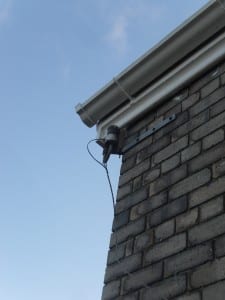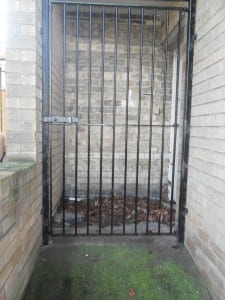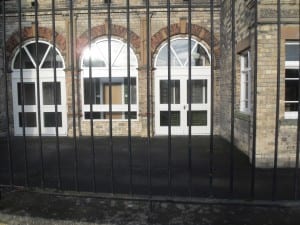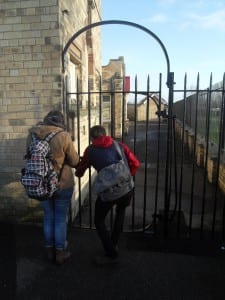After many trips to the Grand Stand, exploring inside and on the land around it, it became clear what me, Charlie Restall and Daniel Ridealgh wanted to research about the site. There is a slight difference in the old and the new architecture of the building, mainly the colour of the bricks. But we noticed that objects had been taken away from the architecture, such as the tannoys that were used deliver the horse racing news and notices to the public who used to go to the Grand Stand. We were able to find the remaining hooks that the tannoy wires would have been supported by on the bricks. The main idea that came about from the removal of the tannoys was the loss of voice from the site. It could no longer speak, forever muted; it gave the building a sense of isolation, the voice trapped inside. This became a starting point for our performance; it was up to us to restore those tannoys. A simple sound system which would give the Grand Stand an ability to speak, perhaps reply the announcements of the past races.
While researching Lincolnshire and the Grand Stand during the 19th and 20th centuries at the Lincolnshire Archives, we came across two other stands that used to be a part of the site but unfortunately got demolished, the date we are unsure of. The significance of this research was that what we’ve always known as the Grand Stand is actually the Tattersall’s Stand and because it was the only surviving building it got renamed the Grand Stand. The memories from the demolished buildings no longer exist, they got destroyed. Mike Pearson states that “landscape becomes embedded with memory” ((Pearson M. (2010) Site-Specific Performance, London: Palgrave Macmillan, p. 95)) and we plan to bring back the memories, which were created by the public during the races, to the landscape surrounding the site. This will be done by attempting to re-produce the original Grand Stand and the Silver Ring Stand. Through research the measurements of these buildings have been found, so our recreation will be exactly to scale, we hope. Not only will this bring back the lost memories, it will also create new ones with the audience we bring into our performance that have never stepped foot on our site before. From this it may be seen that “performance can play a role in the public engagement with landscape’ ((Pearson M. (2011) Why Performance?)), our audience will be able to engage with the ‘restored’ stands once again by learning what was lost from the landscape and imagining it’s past appearance.
The British company, Station Opera House, are known for building structures of an architectural scale. They use thousands of concrete blocks to create a breezeblock structure. One out of many of their famous pieces is The Bastille Dances (1989) where they used 8000 of these concrete blocks in the construction. It was assembled and dismantled over the course of nine days by the company and was initially created to represent the French Revolution. It started off as an image of the demolition of the Bastille in Paris with the concrete blocks dispersing, representing it’s destruction through the city. This company’s ideas are fairly similar to what we want to do. Re-creating the other stands on a grand scale and then tear it all down to show the destruction and loss of these buildings, what it has done to the landscape as a consequence – it no longer looks like the Grandstand, just an old building left deteriorate. Yi-Fu Tuan argues in his book Space and Place: The Perspective of Experience that “architecture can educate people’s awareness and concept of reality” ((Tuan Y. (1997) Space and Place: The Perspective of Experience, London: Edward Arnold, p. 117)) , we aim teach and inform our audience of the site’s history so they are no longer ignorant of how the past and present society that we currently live in has let the Grandstand decay into nothing. The easiest way to do this is to give it back its voice and bring the buildings to life once again, by bringing Lincoln’s history to present day it is will also help the other groups performances who aim to go further back in history before the Grandstand itself existed.
Here is a video of our group’s first attempt at re-creating the original Grand Stand:



